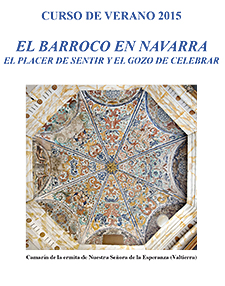THE BAROQUE IN NAVARRA. THE PLEASURE OF FEELING AND THE JOY OF CELEBRATING
September 15, 2015
The Baroque: An invention of the 20th century?
Mr. Javier Portús Pérez. National Museum of the Prado
Approaches to Baroque art are very often preceded by a reflection on the meanings of the term and a review of its historiography. This is a phenomenon that is more intense than in other periods, which indicates to what extent we are dealing with a "construction"; a construction linked to the interests of the period in which it is formulated. In this case, the full reflection and characterization of the "baroque" are intimately related not only to the historiographical interests of the 20th century, but also to the intellectual concerns of that period and to the statement of core values of numerous contemporary artists.
Although the first definitions of the Baroque date back to the 19th century, its first systematization was made exactly a century ago, through Wölffling's Fundamental Concepts of Art History , who established a series of categories that served to define the Baroque in civil service examination to the "classical". Although this methodology was reductive, since it marginalized artists and periods that did not fully participate in any of the characteristics, it was very useful to give "a letter of nature" to the Baroque, which from then on was considered as one of the great moments in the History of Art, with its own characteristics and values; and not as a simple derivation of the Renaissance.
Over time, the definition of "Baroque" was broadened, and was no longer only used to characterize concepts of a purely formal nature, as it was extended to other areas of experience. Thus, as the use of the term became common, so did its definition. In the 1930s, Eugenio D'Ors used it to characterize recurring trends throughout the history of art and the history of culture in general. As time went by, programs of study multiplied with a very broad definition of the term, which since then has not only alluded to formal phenomena. Thus, both Weisbach and Mâle associated it with the spiritual currents promoted by the Counter-Reformation; and since the middle of the 20th century there has been a widespread awareness that the process of formal renewal that took place during the 17th century also extended to pictorial genres, leading to the appearance of themes such as the still life and a new interest in nature. During this time, the Baroque has gone from being a term in the domain of art historians to extend also to historians of literature and culture in general. Within the latter field, it was the subject of a rigorous attempt at characterization in Juan Antonio Maravall's La cultura del barroco (The Culture of the Baroque).
At the same time that historians of art, literature and culture were reflecting on the Baroque, so were artists. An important current of 20th century creators, including Picasso, Henry Moore, Pollock, Bacon, Giacometti and Saura, have been deeply interested in the formal phenomena associated with their definition of the "baroque". A definition, on the other hand, that does not always coincide with that of historians, as it often includes Tintoretto, Michelangelo or El Greco. The fact is that reflection on these and other "baroque" artists has become an important driving force for a significant part of the renewal of art in the 20th century.
PROGRAM
Tuesday, 15th September
The Baroque, an invention of the 20th century?
Javier Portús Pérez. Prado National Museum
Does the Baroque exist in Navarre?
D. Ricardo Fernández Gracia. Chair of Heritage and Art of Navarre
Wednesday, 16th September
"Plegaria de ladrillo y sillar" (Brick and ashlar prayer). Religious architecture in the Navarrese Baroque
Mr. José Javier Azanza López. Chair of Navarrese Heritage and Art
The construction of an image of power: town planning, houses and palaces.
Ms. Pilar Andueza Unanua. Chair of Navarrese Heritage and Art
Thursday, 17th September
Of chisel, hammer and paintbrush. The visual arts at the service of the Church and power
D. Ricardo Fernández Gracia. Chair of Navarrese Art and Heritage.
Jewellery and silver. Adornment and function
Mª Concepción García Gainza. Chair of Heritage and Art in Navarre
presentation of the book Alonso Cano and the Lekaroz Crucifixion
Mª Concepción García Gainza. Chair de Patrimonio y Arte navarro

